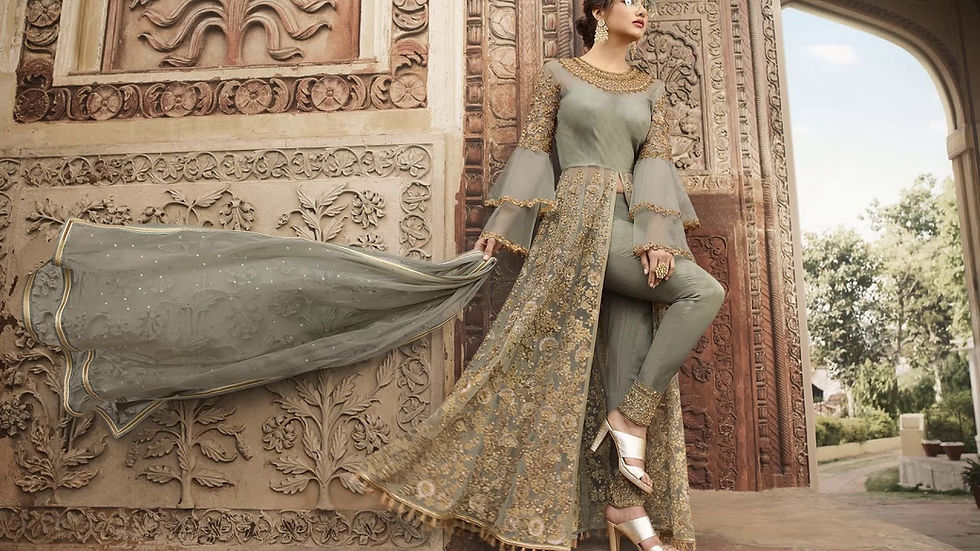Crafting Memories: The Emotional Significance of Pakistani Bridal Outfits
- Karma Collection
- Jan 7, 2024
- 3 min read

Pakistani bridal outfits stand as remarkable symbols, not just of elegance and tradition but also as vessels holding profound emotional significance. In Pakistani culture, weddings are not merely ceremonies; they are grand celebrations infused with deep-rooted traditions. Central to these celebrations are the bridal ensembles, rich in history, cultural heritage, and emotional resonance. Beyond their aesthetic beauty, these outfits encapsulate a myriad of emotions and stories, transcending mere fabric to become repositories of cherished memories.
The Evolution of Pakistani Bridal Fashion
The history of Pakistani bridal wear is a tapestry woven with threads of tradition and innovation. From the opulent Mughal era to the contemporary fusion trends, bridal fashion has undergone a remarkable evolution. Traditional garments like the lehenga choli, sharara, and gharara have retained their charm while adapting to modern aesthetics. Intricate embroideries, such as zardozi and gota work, have continued to be the hallmark of Pakistani bridal couture, passed down through generations, preserving the essence of cultural heritage.
Cultural Symbolism and Significance
Pakistani bridal attire transcends its role as mere clothing; it symbolizes cultural values, family heritage, and regional diversity. Each outfit carries profound symbolism, often reflecting the bride's familial origins or honoring ancestral traditions. The vibrant colors, intricate patterns, and embellishments hold deeper meanings, signifying prosperity, fertility, and joy. For instance, red symbolizes auspiciousness in many regions, while green signifies fertility and new beginnings. These outfits serve as a bridge connecting the bride to her roots, encapsulating familial blessings and aspirations for the future.
Emotional Connections and Sentiments
The selection of a bridal outfit is an emotionally charged experience, intertwining nostalgia, dreams, and aspirations. Families invest considerable time and effort in choosing the perfect attire, often passed down as heirlooms, embodying sentimental value. The process involves an intricate dance of emotions—excitement, joy, and sometimes a tinge of melancholy as traditions evolve. Brides feel a profound connection to their heritage and ancestors, donning these ensembles with reverence and pride. The moments spent adorning these garments are cherished, creating lasting memories and binding the wearer to her cultural identity.
Contemporary Trends and Adaptations
While preserving tradition, Pakistani bridal fashion has also embraced contemporary influences. Designers experiment with innovative cuts, fabrics, and fusion styles, catering to the modern bride's preferences. Embroidery techniques are evolving, incorporating modern elements without compromising the essence of heritage. Additionally, the rise of online platforms has widened access to diverse styles, allowing brides to explore a plethora of options, from traditional to contemporary, and make informed choices.
The Evolution of Pakistani Bridal Fashion
Pakistani bridal wear has witnessed a remarkable evolution, reflecting the country's diverse history and cultural amalgamation. The influence of the Mughal era continues to resonate in contemporary designs, with intricate embroideries like zardozi and kora-kam making a significant impact. Traditional silhouettes such as the lehenga choli, sharara, and gharara have stood the test of time, undergoing subtle modifications to suit modern tastes while maintaining their cultural essence. The fusion of traditional craftsmanship with modern aesthetics has created a unique identity for Pakistani bridal fashion, admired globally for its opulence and elegance.
Cultural Symbolism and Significance
Each element of a Pakistani bridal outfit carries profound cultural symbolism, rooted in traditions and beliefs. The color palette, adorned with vibrant hues like red, symbolizes joy, prosperity, and fertility. Different regions showcase distinct preferences in colors and motifs, infusing deeper significance into the attire. Gold and silver embroidery symbolize wealth and purity, while intricate patterns like paisleys and florals carry cultural stories and blessings. The selection of attire often reflects familial traditions and values, with brides honoring their heritage through intricate detailing that tells a story of their roots. These garments serve as visual representations of a bride's journey, embodying familial blessings and aspirations for a blissful married life.
Emotional Connections and Sentiments
The process of selecting a bridal outfit is an emotionally charged experience that holds immense sentimental value. It involves a harmonious blend of anticipation, nostalgia, and joy, as families embark on this journey steeped in tradition. Brides often inherit heirloom pieces, making the attire not just a garment but a tangible link to familial legacies and ancestral blessings. The emotional significance deepens as brides undergo rituals while donning these outfits, surrounded by loved ones, creating everlasting memories. The emotional connection between the bride and her ensemble extends far beyond its material worth, evoking sentiments of pride, belonging, and a shared cultural identity.
Conclusion
In essence, Pakistani bridal outfits are not merely garments; they are repositories of emotions, narratives, and cultural heritage. These intricate ensembles encapsulate a bride's journey, from tradition to modernity, binding her to her roots while embracing the future. Their emotional significance extends beyond fashion, making them timeless treasures and an integral part of cherished memories.



Comments